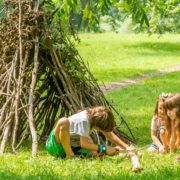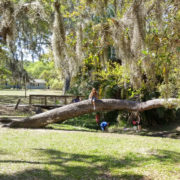Nature play builds resilient, curious kids
With the launch of Rio Tinto Naturescape Kings Park, Perth kids can problem solve, build resilience and practise enquiry-based learning through nature play.
Last month, I attended the official launch of stage two of Rio Tinto Naturescape Kings Park. I got to climb over rocks, poke my head into hidey-holes and even dip my toes in the water of this amazing nature play area.
If you haven’t been keeping up to date with your local parenting groups, you might not know what ‘nature play’ is, let alone realise what it has to do with science!
Prepare to get your hands dirty because nature play is all about getting back to the bush.
Back in my day …
Anyone over the age of 30 probably remembers spending most of their childhood outdoors.
My parents love to tell me how, when they were kids, their parents would shoo them out of the house in the morning, and they were expected to entertain themselves outdoors until tea time. They’d spend glorious days exploring on their banana seat bikes and running through the bush.
Nowadays, stranger danger is high, kids are overscheduled and their downtime is often screen time.
The idea behind nature play—unstructured play outdoors—is to bring things back to basics. It allows kids to explore the natural environment by giving them a safe space to do so.
“That opportunity just to run around in the bush and make mud pies and build cubby houses is lost to [the kids of today],” says Jacqui Kennedy, head of the Kings Park education team.
“So that’s what we wanted to bring back for them, because in doing that, they’re using their imaginations and … actually really using their brain to discover new things, to problem solve”.
“Play is the highest form of research”
This quote probably wasn’t uttered by Einstein as Google suggests, but there’s still a lot of truth to it.
At the core of all research is curiosity and the desire to answer questions.
Nature play allows children to be scientists by getting them curious about the world around them and encouraging them to answer questions.
“If you love the environment and you’re connected with it, you want to delve deeper and engage and ask questions,” says Kiely O’Flaherty, a Kings Park education officer.
“I’ve got kids myself, and it’s nice to actually be able to reconnect with the kids and get excited by their questions and then try to help them discover answers.”
This learning through asking questions is called enquiry-based learning.
“Naturescape itself is built for enquiry-based learning and science,” says Charlotte Vaughan, Kings Park’s education coordinator.
“By having a play space that kids connect with nature and get excited by nature—that leads to science,” adds Kiely.
Play space not playground
If you’re going to get back to nature, you’ve got to do it right.
You won’t find any brightly coloured plastic swings or slides at Rio Tinto Naturescape Kings Park. What you will find are branches to build a cubby house, trees to climb, water to wade in and a mud-making station.
“We decided early on, when we wanted to connect children with nature, we didn’t want there to be a plastic experience,” says Jacqui.
“It was very much decided that, if children were going to build their resilience and take risks and problem solve and do all of those things that help with their physical and cognitive development, we needed to not provide a playground but more a discovery and learning facility, and that’s what it is.”
So how does playing with mud and sticks help build resilience?
Well, it’s a chance for kids to challenge themselves and take risks. There’s no instructions to tell you what to do, so you can set your own tasks and try and solve your own problems.
For example, if you’re building a cubby house, there are many ways you can challenge yourself. Can you make a door that opens and closes? Can you tip water on your roof and make sure it doesn’t leak?
Overcoming each problem builds resilience and encourages creativity.
Creating future custodians
When you’re talking about a nature play area, you can’t ignore the benefits to nature.
Kids experiencing the natural world means kids learning to appreciate the natural world. Things you can see and touch are things you want to protect.
And that’s what kids do at Rio Tinto Naturescape Kings Park when they play in the water of the new Paperbark Creek and explore the treetops on the new Python.
“If we want children to be our custodians of the environment in the future, well, they have to have developed their empathy during their formative years,” says Jacqui.
“Because if there’s no knowledge, there is no empathy, and without that, there is no action to protect so it’s vitally important for the environment.”
By teaching kids through play how to respect and care for our natural environment, we can ensure it’ll be in safe hands for generations to come.
And who knows? Maybe you’ll find some serenity there too!
This article was originally published on Particle. Read the original article.



